The loneliest place in the county. Even people who profess to have a knowledge of Sussex have never heard of it. In loneliness lies beauty. Penhurst is a church, a manor house and a few farm buildings; a living picture of old England that has scarcely changed since Shakespeare’s day. The hairpin lanes that shield it from the rest of the world are calculated to cut it off completely during the winter.
In the Elizabethan manor house are the last three firebacks cast at the last furnace of the Sussex iron industry at neighbouring Ashburnham. The man who did the job before the fire was extinguished for good in 1813 has been recorded for posterity. He was Will Rummins according to a former rector of Penhurst, the Rev R.W. Whistler, who was given the name by the last labourer at Ashburnham Furnace, William Hobday, who died in August 1883.
Joseph Wise, rector for 46 years until his death in 1810, managed to maintain a family of nine children on a stipend of £100 per annum. He supplemented his income by publishing a number of books, including an Ode on the marriage of George III and Queen.
A little ingenuity keeps the congregation comfortable in the winter when hot air is pumped into the church by an agricultural corn drier. The old copper lamp at the entrance to the churchyard strikes an even more incongruous note; it once lit the streets of Clerkenwell in London.
In an area of such solitude the 20th century can be left behind and it is easy to believe the legend that in the sinister sounding Creep Wood the Britons made a last stand in a desperate battle against the Saxons.
